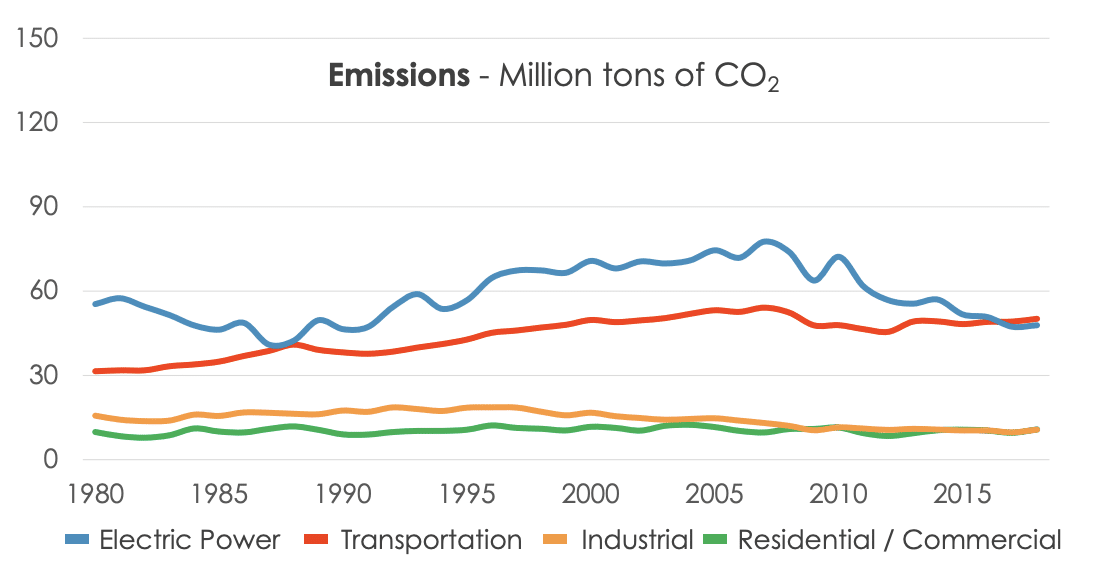Today, January 7, North Carolina Governor Roy Cooper announced Executive Order 246, reflecting the energy and transportation leadership we at the Southern Alliance for Clean Energy (SACE) and other advocates have called for. Not only are the carbon emission reduction and transportation targets in EO 246 among the most aggressive in the country, but most importantly, it centers equity and justice.
This EO builds on plans that began in 2018 with another Executive Order, EO 80, that commits the state to address climate change and building a clean energy economy. The Cooper Administration’s Climate Change Interagency Council has led essential planning processes since EO 80, which will feed into implementing economy-wide and transportation-specific decarbonization in an equitable manner.
The clean energy and electric transportation sectors are expanding rapidly while the impacts from climate change are simultaneously worsening, creating significant opportunities and at the same time exposing increasing risks posed by the status quo. Today’s executive order seeks to maximize the economic and public health opportunities that will result from aggressively decarbonizing the state’s economy. Success will stimulate private-sector investment and create jobs while reducing North Carolinians’ economic and public health exposure to climate risks.
North Carolina Goals Aligned With What’s Needed
EO 246 seeks to align North Carolina’s greenhouse gas emissions (GHG) goals with a decarbonization trajectory that science indicates is necessary to mitigate the most damaging impacts of the climate crisis. These targets are in line with goals adopted by 23 other states and the District of Columbia, as well as the Paris Agreement ratified by over 190 countries, including the United States. They include:
- Reducing statewide GHG emissions to at least 50% below 2005 levels by 2030 and achieving net-zero emissions as soon as possible, no later than 2050;
- Reducing transportation sector emissions by increasing the total number of registered zero-emission vehicles (ZEVs) to at least 1,250,000 by 2030 and increasing the sale of ZEVs so that 50% of in-state sales of new vehicles are ZEVs by 2030.
SACE applauds Governor Cooper’s ambitious and attainable goals; anything less would fall short of what is needed. Additionally, SACE commends the proposed actions that are innovative and reflective of the need to ensure the transition to a clean energy economy is just and equitable.
Centering Equity, Justice, and Public Participation
Climate change is already impacting North Carolinians, and it disproportionately affects people of color, indigenous communities, and low-income communities. Governor Cooper is correct that the responsible response to the climate crisis are solutions centering equity and justice. EO 246 makes clear, and SACE agrees, that to center decarbonization efforts around urgent equity and justice needs, it is imperative to:
- Create environmental justice (EJ) leads at cabinet agencies,
- Require public participation plans for each agency,
- Launch a public process to determine what EJ considerations need to be part of emissions reduction strategies,
- Develop guidelines to ensure the disbursement of state and federal funds advances equity, affordability, and resilience goals, and
- Expand clean energy workforce development opportunities in underserved communities.
Decarbonization Pathways Analysis
Developing an economy-wide deep decarbonization pathway analysis will provide guidance across industries and identify where the greatest and quickest emissions reductions exist. This analysis can build upon work the administration has done following EO 80, including the development of the North Carolina Clean Energy Plan that SACE and others called for, and subsequent reports on policies to reduce carbon emissions in the power sector and regulatory reforms for the power sector.
These analyses, combined with other EO 80 plans, lay the foundation for an economy-wide analysis. Although transportation recently overtook electric power as the highest emitting sector in the state, it is important to remember that the two sectors are linked, and that cleaning the grid and electrifying transportation is the primary way to reduce overall emissions.

Governor Cooper’s new EO launches 12 months of pathways analysis to be developed – in parallel to the Carbon Plan that HB 951 tasked the North Carolina Utilities Commission (NCUC) with finalizing by December 31, 2022. That Carbon Plan will be the blueprint Duke Energy’s two North Carolina-based utilities will use to reduce carbon emissions 70% from 2005 levels by 2030.
Social Cost of Carbon
Decarbonazion investments must be grounded in understanding the total cost of climate action vs. inaction. By including the social cost of GHG emissions in state agency planning and guidelines, Cooper will ensure that the long-term economic costs and benefits of emissions reductions across all sectors of the economy are considered in upcoming decisions. Of particular note is that the EO explicitly encourages (but does not require) the NCUC to incorporate the social cost of GHG emissions into its decision-making. If the Order did require it, it could have far-reaching impacts on electric utilities that operate in the state, since they must go to the NCUC for approval of everything from rates and resource plans to energy efficiency programs and the compensation for customer-sited solar.
Clean Transportation Plan
As explained above, transportation is the leading GHG emitting sector today. To achieve economy-wide decarbonization goals, it is therefore critical to electrify cars, trucks, and buses; reduce vehicle miles traveled; ensure equitable access to clean mobility; and increase walkability and bike-ability across the state. In coordination with existing efforts to decarbonize the electricity sector, developing a comprehensive Clean Transportation Plan to rapidly achieve these needs will help deliver substantial GHG emissions reductions.

North Carolina has already seen significant utility investment and government funding in the electric transportation market – EO 246 will help propel those and other indicators forward.
Moving Forward
SACE looks forward to working alongside Governor Cooper’s office, state agencies, and our fellow stakeholders to achieve EO 246’s bold and critical goals, and to doing our part to hold the process accountable to its equity and justice commitments.
#NCCarbonPlan